Pharmacological modulators of nav1.1 voltage-gated sodium channels associated with mechanical pain
a technology of voltage-gated sodium channels and modulators, which is applied in the field of multimodal systems to achieve the effects of inhibiting mechanical pain, inhibiting allodynic pain, and inhibiting non-inflammatory pain
- Summary
- Abstract
- Description
- Claims
- Application Information
AI Technical Summary
Benefits of technology
Problems solved by technology
Method used
Image
Examples
example 1
[0178]Venom Screen Identifies Selective Nav1.1 Activating Toxins.
[0179]To identify novel toxins that target primary afferent nociceptors, we used calcium imaging to screen a collection of 109 spider, scorpion and centipede venoms for the ability to activate cultured somatosensory neurons. Venom from the tarantula Heteroscodra maculata (FIG. 1a) robustly excites a subset of neurons from trigeminal ganglia (TG) or dorsal root ganglia (DRG) from mice or rats. Venom fractionation yielded two active peaks, which were identified by MALDI-MS and Edman sequencing. We named these toxins δ-theraphotoxin-Hm1a (Hm1a) and δ-theraphotoxin-Hm1b (Hm1b), two inhibitor cysteine knot (ICK) peptides of related sequence. Applying synthetic Hm1a to rat DRG neurons likewise triggers calcium responses (FIG. 1b), validating Hm1a as an active venom component. All subsequent experiments were performed with synthetic Hm1a peptide unless otherwise stated.
[0180]Tetrodotoxin (TTX) blocked Hm1a-evoked calcium resp...
example 2
[0183]Hm1a Selectivity Depends on the S1-S2 loop in DIV of Nav1.1.
[0184]Analysis of Hm1a effects reveals that the toxin inhibits both the speed and extent of fast inactivation (FIG. 2a), similar to the mechanism described for less selective peptide toxins that bind to the S3b-S4 voltage sensor region of Domain IV (DIV)23. To determine whether Hm1a targets the same locale, we transferred each of four S3b-S4 regions from hNav1.1 into the cognate location of the homo-tetrameric rKv2.1 channel, which is normally insensitive to the toxin. Indeed, transfer of just the DIV S3b-S4 region renders rKv2.1 susceptible to Hm1a, demonstrating that this segment is a primary determinant of toxin action (FIG. 2b). However, this region is identical or highly conserved in hNav1.1, 1.2 and 1.3, and thus while the toxin may interact with DIV S3b-S4, such interaction does not fully account for toxin selectivity. To identify additional regions that specify toxin selectivity, we constructed chimeras betwee...
example 3
[0185]Nav1.1 is not Expressed in Classic C-Fiber Nociceptors.
[0186]Previous studies have shown that Nav1.1 is expressed by medium and large diameter, myelinated sensory neurons7, consistent with our data showing selective enrichment of Nav1.1 transcripts in medium diameter (cross-sectional area 400-700 μm2) neurons in adult mouse DRG (FIG. 3). We detected Nav1.1 mRNA in 35% of all cells, most of which (>75%) belong to the myelinated (NF200-positive) cohort. In contrast, we observed limited (5-11%) overlap of Nav1.1-positive cells with markers of small diameter, unmyelinated neurons, including TRPV1, CGRP, tyrosine hydroxylase and the lectin IB4. However, we did see substantial co-expression with the 5-HT3 receptor (43% of Nav1.1-positive cells express 5-HT3), a serotonin-gated channel that is expressed primarily by lightly myelinated Aδ neurons29. Finally, 22% of Nav1.1-positive cells also expressed the cold / menthol receptor, TRPM8, which is found in both C and Aδ fibers30. Taken to...
PUM
| Property | Measurement | Unit |
|---|---|---|
| forces | aaaaa | aaaaa |
| forces | aaaaa | aaaaa |
| forces | aaaaa | aaaaa |
Abstract
Description
Claims
Application Information
 Login to View More
Login to View More - R&D
- Intellectual Property
- Life Sciences
- Materials
- Tech Scout
- Unparalleled Data Quality
- Higher Quality Content
- 60% Fewer Hallucinations
Browse by: Latest US Patents, China's latest patents, Technical Efficacy Thesaurus, Application Domain, Technology Topic, Popular Technical Reports.
© 2025 PatSnap. All rights reserved.Legal|Privacy policy|Modern Slavery Act Transparency Statement|Sitemap|About US| Contact US: help@patsnap.com



